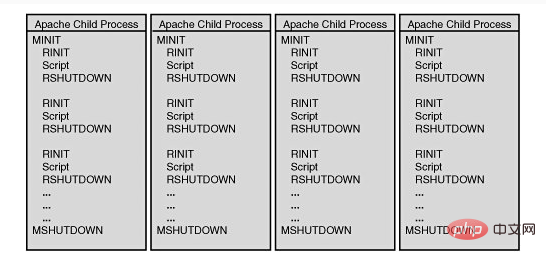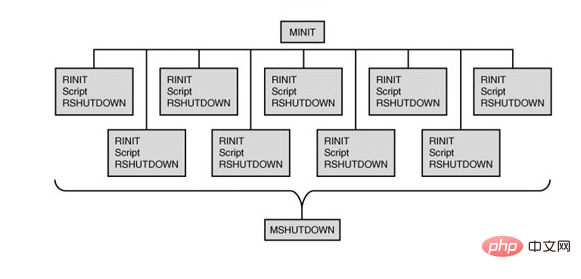php life cycle

1. PHP operating mode:
The two operating modes of PHP are WEB mode and CLI mode. Regardless of the mode, PHP works the same, running as a SAPI.
1. When we type the php command in the terminal, it uses the CLI.
It is like a web server to support php to complete the request. After the request is completed, control is returned to the terminal.
2. When using Apache or another web server as the host, when a request comes, PHP will support the completion of the request. Generally:
Multi-process (usually compiled into apache module to handle PHP requests)
Multi-threaded mode
Brief execution process:
1 . PHP runs when Apache is started;
2. PHP is connected to Apache through the mod_php5.so module (specifically, SAPI, the server application programming interface);
3. PHP There are three modules in total: kernel, Zend engine, and extension layer;
4. PHP kernel is used to handle requests, file streams, error handling and other related operations;
5. Zend engine (ZE) is used to convert source files Convert it into machine language, and then run it on a virtual machine;
6. The extension layer is a set of functions, class libraries, and streams that PHP uses to perform some specific operations. For example, we need the MySQL extension to connect to the MySQL database;
7. When ZE executes the program, it may need to connect to several extensions. At this time, ZE will hand over control to the extension and return it after processing the specific task;
8. Finally, ZE returns the program running results to the PHP kernel, which then transmits the results to the SAPI layer and finally outputs them to the browser.
2. Several stages of running PHP:
SAPI runs PHP through the following stages:
1. Module initialization stage (Module init):
That is, calling each The method in PHP_MINIT_FUNCTION in the extension source code initializes the module, applies for some variables required by the module, allocates memory, etc.
2. Request initialization phase (Request init):
After receiving the client's request, the method in each extended PHP_RINIT_FUNCTION is called to initialize the execution environment of the PHP script.
3. Execute PHP script
4. Request Shutdown:
At this time, the PHP_RSHUTDOWN_FUNCTION method of each extension is called to clean up the request site, and ZE begins to recycle variables and memory.
5. Module shutdown:
When the web server exits or the command line script is executed and exits, the PHP_MSHUTDOWN_FUNCTION method in the extension source code will be called
3. SAPI life cycle under various circumstances.
1. Single-process SAPI life cycle. (CGI)
CLI/CGI mode PHP belongs to the single-process SAPI mode. This type of request is closed after processing the request once. That is to say, each request will repeat these steps: start - request start - request close - end. You can see that the initialization of the extension consumes a lot of resources.
2. Multi-process SAPI life cycle. (MPM's perfork method)
Usually PHP is compiled into a module of apache to handle PHP requests (mod_php). Apache generally adopts multi-process mode. After Apache is started, it will fork out multiple child processes (apache can specify the number of processes to start forking out). The memory space of each process is independent, and each child process will go through the start and end stages as soon as it is focked.

3. Multi-threaded SAPI life cycle. (Single process in FastCGI or MPM work mode)
Multi-threading mode is similar to a process in multi-process. In this mode, only one server process is running, but many threads will be running at the same time. This can reduce some resource overhead and reduce the cost to Module init and Module shutdown. It only needs to be run once, and some global variables only need to be initialized once. Because of the unique characteristics of threads, it is possible to conveniently share some data between requests.

For more PHP related technical articles, please visit the PHP Tutorial column to learn!
The above is the detailed content of php life cycle. For more information, please follow other related articles on the PHP Chinese website!

Hot AI Tools

Undresser.AI Undress
AI-powered app for creating realistic nude photos

AI Clothes Remover
Online AI tool for removing clothes from photos.

Undress AI Tool
Undress images for free

Clothoff.io
AI clothes remover

Video Face Swap
Swap faces in any video effortlessly with our completely free AI face swap tool!

Hot Article

Hot Tools

Notepad++7.3.1
Easy-to-use and free code editor

SublimeText3 Chinese version
Chinese version, very easy to use

Zend Studio 13.0.1
Powerful PHP integrated development environment

Dreamweaver CS6
Visual web development tools

SublimeText3 Mac version
God-level code editing software (SublimeText3)

Hot Topics
 1387
1387
 52
52
 PHP 8.4 Installation and Upgrade guide for Ubuntu and Debian
Dec 24, 2024 pm 04:42 PM
PHP 8.4 Installation and Upgrade guide for Ubuntu and Debian
Dec 24, 2024 pm 04:42 PM
PHP 8.4 brings several new features, security improvements, and performance improvements with healthy amounts of feature deprecations and removals. This guide explains how to install PHP 8.4 or upgrade to PHP 8.4 on Ubuntu, Debian, or their derivati
 7 PHP Functions I Regret I Didn't Know Before
Nov 13, 2024 am 09:42 AM
7 PHP Functions I Regret I Didn't Know Before
Nov 13, 2024 am 09:42 AM
If you are an experienced PHP developer, you might have the feeling that you’ve been there and done that already.You have developed a significant number of applications, debugged millions of lines of code, and tweaked a bunch of scripts to achieve op
 How To Set Up Visual Studio Code (VS Code) for PHP Development
Dec 20, 2024 am 11:31 AM
How To Set Up Visual Studio Code (VS Code) for PHP Development
Dec 20, 2024 am 11:31 AM
Visual Studio Code, also known as VS Code, is a free source code editor — or integrated development environment (IDE) — available for all major operating systems. With a large collection of extensions for many programming languages, VS Code can be c
 Explain JSON Web Tokens (JWT) and their use case in PHP APIs.
Apr 05, 2025 am 12:04 AM
Explain JSON Web Tokens (JWT) and their use case in PHP APIs.
Apr 05, 2025 am 12:04 AM
JWT is an open standard based on JSON, used to securely transmit information between parties, mainly for identity authentication and information exchange. 1. JWT consists of three parts: Header, Payload and Signature. 2. The working principle of JWT includes three steps: generating JWT, verifying JWT and parsing Payload. 3. When using JWT for authentication in PHP, JWT can be generated and verified, and user role and permission information can be included in advanced usage. 4. Common errors include signature verification failure, token expiration, and payload oversized. Debugging skills include using debugging tools and logging. 5. Performance optimization and best practices include using appropriate signature algorithms, setting validity periods reasonably,
 How do you parse and process HTML/XML in PHP?
Feb 07, 2025 am 11:57 AM
How do you parse and process HTML/XML in PHP?
Feb 07, 2025 am 11:57 AM
This tutorial demonstrates how to efficiently process XML documents using PHP. XML (eXtensible Markup Language) is a versatile text-based markup language designed for both human readability and machine parsing. It's commonly used for data storage an
 PHP Program to Count Vowels in a String
Feb 07, 2025 pm 12:12 PM
PHP Program to Count Vowels in a String
Feb 07, 2025 pm 12:12 PM
A string is a sequence of characters, including letters, numbers, and symbols. This tutorial will learn how to calculate the number of vowels in a given string in PHP using different methods. The vowels in English are a, e, i, o, u, and they can be uppercase or lowercase. What is a vowel? Vowels are alphabetic characters that represent a specific pronunciation. There are five vowels in English, including uppercase and lowercase: a, e, i, o, u Example 1 Input: String = "Tutorialspoint" Output: 6 explain The vowels in the string "Tutorialspoint" are u, o, i, a, o, i. There are 6 yuan in total
 Explain late static binding in PHP (static::).
Apr 03, 2025 am 12:04 AM
Explain late static binding in PHP (static::).
Apr 03, 2025 am 12:04 AM
Static binding (static::) implements late static binding (LSB) in PHP, allowing calling classes to be referenced in static contexts rather than defining classes. 1) The parsing process is performed at runtime, 2) Look up the call class in the inheritance relationship, 3) It may bring performance overhead.
 What are PHP magic methods (__construct, __destruct, __call, __get, __set, etc.) and provide use cases?
Apr 03, 2025 am 12:03 AM
What are PHP magic methods (__construct, __destruct, __call, __get, __set, etc.) and provide use cases?
Apr 03, 2025 am 12:03 AM
What are the magic methods of PHP? PHP's magic methods include: 1.\_\_construct, used to initialize objects; 2.\_\_destruct, used to clean up resources; 3.\_\_call, handle non-existent method calls; 4.\_\_get, implement dynamic attribute access; 5.\_\_set, implement dynamic attribute settings. These methods are automatically called in certain situations, improving code flexibility and efficiency.




